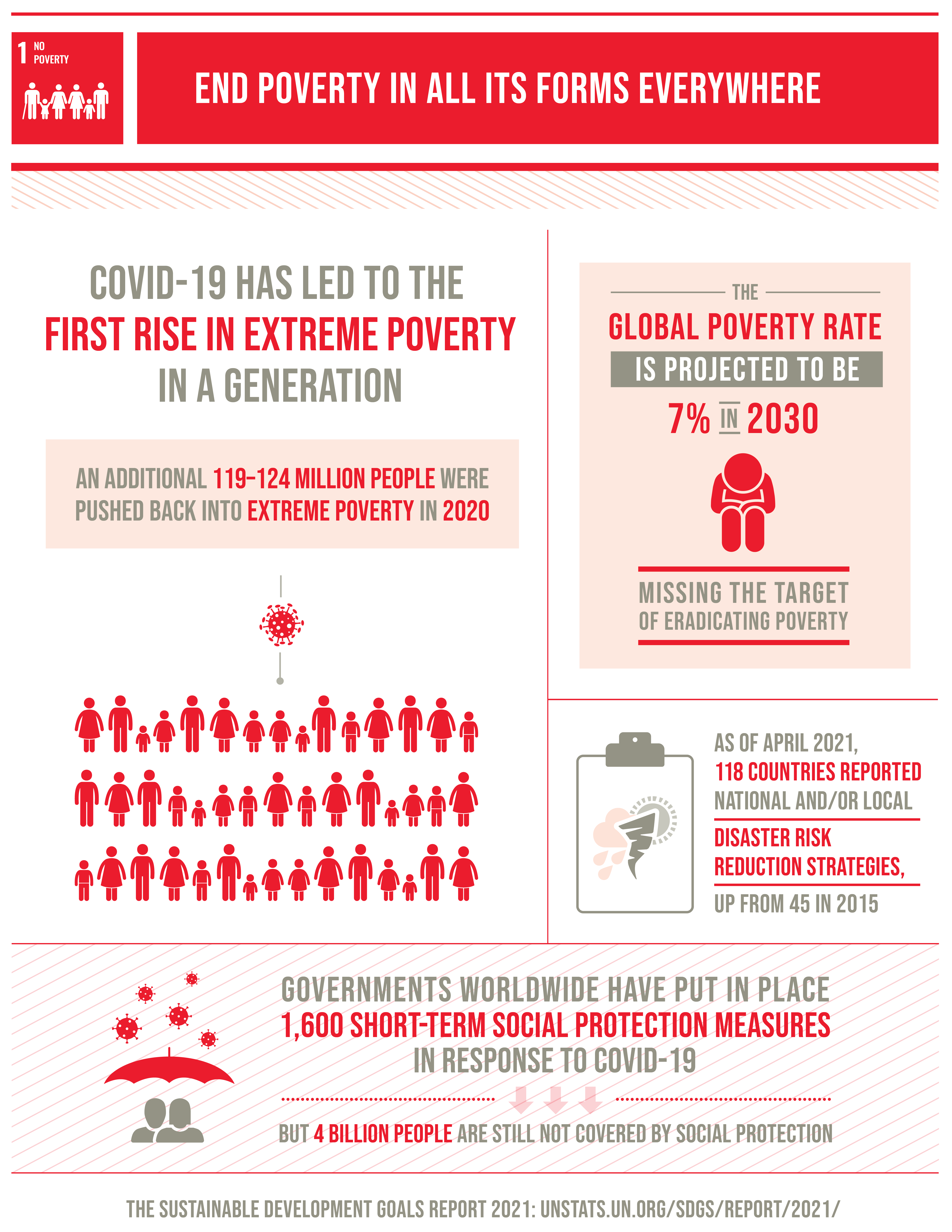



But the pace of change is decelerating and the COVID-19 crisis risks reversing decades of progress in the fight against poverty. New research published by the UNU World Institute for Development Economics Research warns that the economic fallout from the global pandemic could increase global poverty by as much as half a billion people, or 8% of the total human population. This would be the first time that poverty has increased globally in thirty years, since 1990.
More than 700 million people, or 10 per cent of the world population, still live in extreme poverty today, struggling to fulfil the most basic needs like health, education, and access to water and sanitation, to name a few. The majority of people living on less than $1.90 a day live in sub-Saharan Africa. Worldwide, the poverty rate in rural areas is 17.2 per cent—more than three times higher than in urban areas.
For those who work, having a job does not guarantee a decent living. In fact, 8 per cent of employed workers and their families worldwide lived in extreme poverty in 2018. One out of five children live in extreme poverty. Ensuring social protection for all children and other vulnerable groups is critical to reduce poverty.
Facts and Figures:-
- According to the most recent estimates, in 2015, 10 percent of the world’s population or 734 million people lived on less than $1.90 a day.
- Southern Asia and sub-Saharan Africa are expected to see the largest increases in extreme poverty, with an additional 32 million and 26 million people, respectively, living below the international poverty line as a result of the pandemic.
- The share of the world’s workers living in extreme poverty fell by half over the last decade: from 14.3 per cent in 2010 to 7.1 per cent in 2019.
- Even before COVID-19, baseline projections suggested that 6 per cent of the global population would still be living in extreme poverty in 2030, missing the target of ending poverty. The fallout from the pandemic threatens to push over 70 million people into extreme poverty.
- One out of five children live in extreme poverty, and the negative effects of poverty and deprivation in the early years have ramifications that can last a lifetime.
- In 2016, 55 per cent of the world’s population – about 4 billion people – did not benefit from any form of social protection
1.1 By 2030, eradicate extreme poverty for all people everywhere, currently measured as people living on less than $1.25 a day
1.2 By 2030, reduce at least by half the proportion of men, women and children of all ages living in poverty in all its dimensions according to national definitions
1.3 Implement nationally appropriate social protection systems and measures for all, including floors, and by 2030 achieve substantial coverage of the poor and the vulnerable
1.4 By 2030, ensure that all men and women, in particular the poor and the vulnerable, have equal rights to economic resources, as well as access to basic services, ownership and control over land and other forms of property, inheritance, natural resources, appropriate new technology and financial services, including microfinance
1.5 By 2030, build the resilience of the poor and those in vulnerable situations and reduce their exposure and vulnerability to climate-related extreme events and other economic, social and environmental shocks and disasters
1.A Ensure significant mobilization of resources from a variety of sources, including through enhanced development cooperation, in order to provide adequate and predictable means for developing countries, in particular least developed countries, to implement programmes and policies to end poverty in all its dimensions
1.B Create sound policy frameworks at the national, regional and international levels, based on pro-poor and gender-sensitive development strategies, to support accelerated investment in poverty eradication actions
The slowdown in progress on poverty reduction since 2015 has been further set back by the COVID-19 pandemic, with the global rate of extreme poverty rising in 2020 for the first time in over 20 years. The triple threat of COVID-19, conflict and climate change makes the global goal of ending poverty by 2030 unachievable unless immediate and substantial policy actions are taken. The COVID-19 crisis has demonstrated the importance of social protection systems for protecting health, employment and income, with many new social protection measures introduced in 2020 as a result. However, 4 billion people worldwide are still without any social protection, most of whom are poor and vulnerable.
Compounding the threats to poverty eradication posed by climate change and conflict, the pandemic is set to increase the number of poor people in 2020 by between 119 and 124 million, causing the extreme poverty rate to rise for the first time in a generation, from 8.4 per cent in 2019 to 9.5 per cent in 2020 according to “nowcasts”. Of the “new poor”, 8 out of 10 are in middle-income countries and territories. It is predicted that around 600 million people will still be living in extreme poverty by 2030.
Before the pandemic, global extreme poverty had fallen from 10.1 per cent in 2015 to 9.3 per cent in 2017, equivalent to 689 million people living on less than $1.90 a day. However, the rate of decrease had slowed to less than half a percentage point annually in that period, compared to around 1 percentage point annually between 1990 and 2015.
The share of workers around the world living in extreme poverty fell from 14 per cent in 2010 to 7.8 per cent in 2015 and 6.6 per cent in 2019, although progress for young workers was less encouraging. However, the pandemic has severely affected the informal economy, in which the vast majority of the working poor are employed. The crisis also has had a disproportionate impact on the livelihoods of young and female workers, who are already much more likely to be living in poverty. In 2019, young people were twice as likely as adults to be among the working poor.
By 2020, only 47 per cent of the global population was covered effectively by at least one social protection cash benefit, leaving 4 billion people unprotected. However, between 1 February and 31 December 2020, governments of 209 countries and territories announced more than 1,600 mostly short-term social protection measures in response to the COVID-19 crisis.
In 2019, 12,000 disaster fatalities were reported across 72 reporting countries and territories. This is a significant reduction on the figure for 2018, when disaster mortality reported by 105 countries and territories reached a total of 125,000, and is in line with the overall trend in mortality that has been declining since 2005. On the basis of the latest reports submitted as part of the monitoring process under the Sendai Framework for Disaster Risk Reduction 2015–2030, direct economic losses of $9.3 billion were reported for 2019 by 67 countries and territories, of which 68 per cent or $6.4 billion was recorded for the agricultural sector. 18. Only 30 per cent of all countries and territories with data for the period 2015 – 2018 spent between 15 and 20 per cent of total government expenditure on education, as recommended in the Framework for Action for the implementation of Sustainable Development Goal 4.
Total ODA grants for basic social services and development food aid, which are intended for poverty reduction, represented 0.02 per cent of the gross national income of donors to the Development Assistance Committee in 2019.
There are many reasons, but in short, because as human beings, our wellbeing is linked to each other. Growing inequality is detrimental to economic growth and undermines social cohesion, increasing political and social tensions and, in some circumstances, driving instability and conflicts.
Your active engagement in policymaking can make a difference in addressing poverty. It ensures that your rights are promoted and that your voice is heard, that intergenerational knowledge is shared, and that innovation and critical thinking are encouraged at all ages to support transformational change in people’s lives and communities. Governments can help create an enabling environment to generate productive employment and job opportunities for the poor and the marginalized. The private sector has a major role to play in determining whether the growth it creates is inclusive and contributes to poverty reduction. It can promote economic opportunities for the poor. The contribution of science to end poverty has been significant. For example, it has enabled access to safe drinking water, reduced deaths caused by water-borne diseases, and improved hygiene to reduce health risks related to unsafe drinking water and lack of sanitation.
Source:- www.un.org